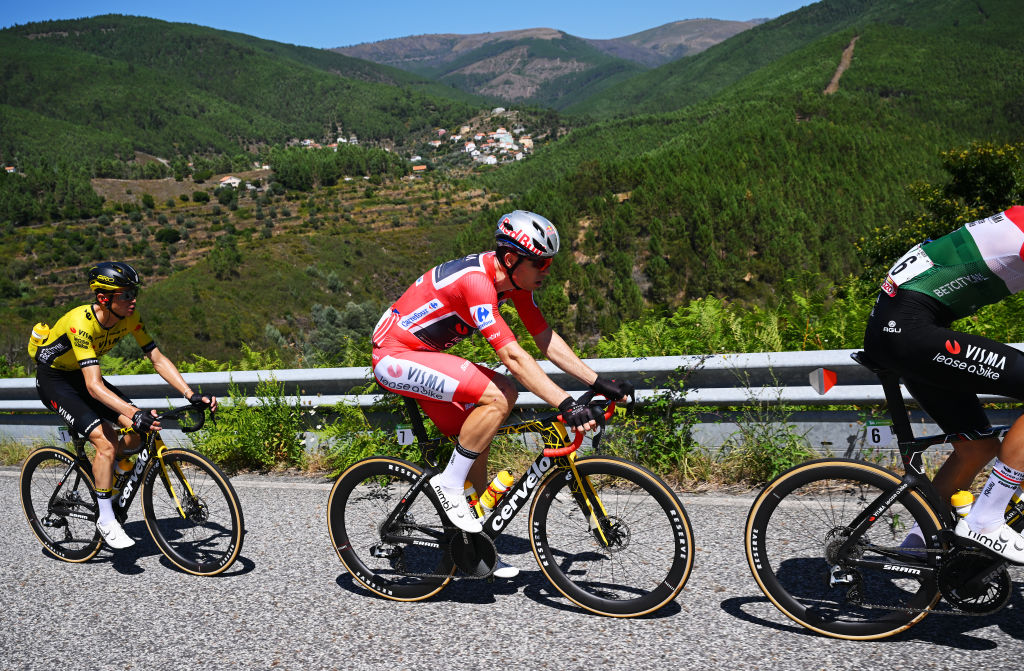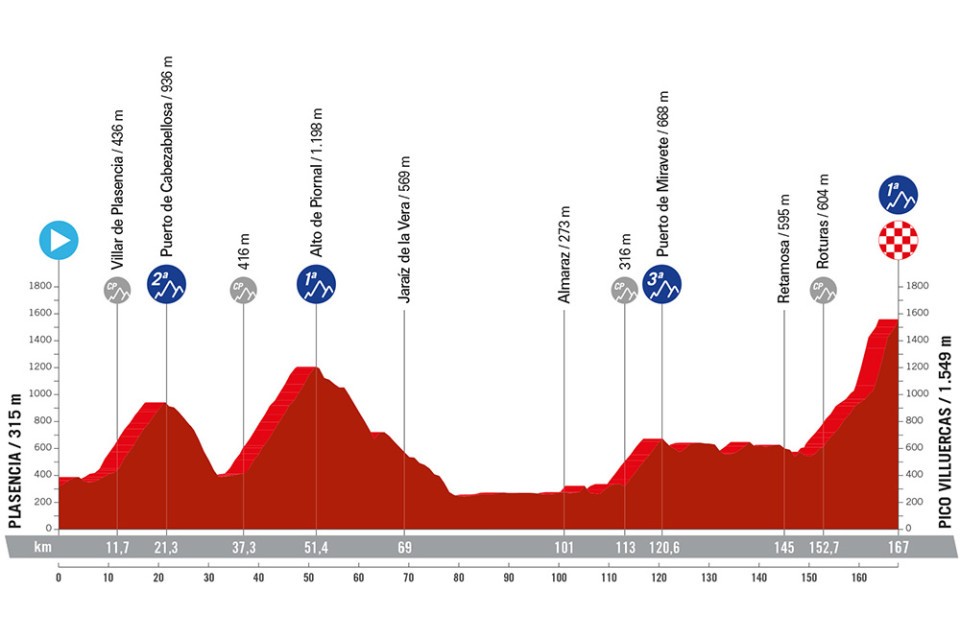
The Vuelta a España never takes very long to go back to the mountains. Even in the opening, seemingly unchallenging stages in Portugal, the 2024 Vuelta peloton has already faced some relentlessly undulating terrain, capped by a brief incursion, early on stage 3, across one of the country’s toughest mountain ranges, the Serra da Estrela.
However, come stage 4 on the return to Spain, the Vuelta really gets back to climbing business with a vengeance. That’s courtesy of its first summit finish, at the Pico Villuercas in the little-known region of Extremadura.
Fourteen kilometres long and rated category 1, Pico Villuercas is mostly a straightforward, steadily rising climb. The one key exception to that rule is a tough middle section, 3km long and averaging a lung-bursting 13%. It’s also preceded on stage 4 by a long but not excessively difficult category 1 climb to El Piornal in the opening kilometres - where Remco Evenepoel took a summit finish win en route to victory in 2022. The 167km stage constantly undulates over rough roads and in some of the most remote areas of western Spain.
The climb is far less familiar than the Vuelta’s usual stomping grounds of Sierra Nevada or Asturias, say, but no matter what, the inclusion of such a tough climb so early on always has the same effect on a Grand Tour peloton. Suddenly, that age-old cliche about a first-week summit finish being where you can’t win a Grand Tour, but you can certainly lose it, begins to do the rounds of the team vehicles and the riders’ dinner tables once again.
Regarding Primož Roglič, triple Vuelta a España winner and considered by many as the number 1 reference point of the 2024 race, there are some key question marks following his injury and abandon in the latest Tour de France. His impressive opening time trial put him in a leading position on the results sheet, and his past track record in the Vuelta further boosted that reputation as the rider to beat. But as Red Bull-Bora-Hansgrohe lead director Rolf Aldag puts it to a small group of media, stage 4 is still something of a voyage in the dark for the Slovenian.
“You shouldn’t compare the years if there have been different approaches to that race,” Aldag said. “He did come back in the past from injuries from the Tour into the Vuelta, and he’s been good, that’s true.
"But there are still differences. We are optimistic, and there is never any reason to go to any race with Primož Roglič to doubt. We always feel like we’ll be in the game, but as for what the outcome will be…
A 12-kilometre opening time trial cannot provide a complete indication of how Roglič will perform over three weeks, but the way the 34-year-old gained time on all his overall rivals, ranging from two seconds on João Almeida (UAE Team Emirates) to over 30 on Sepp Kuss (Visma-Lease a Bike) is hardly a poor omen. However, when it comes to cracking open the champagne, Aldag is keeping the cork firmly on the bottle for now.
“From our perspective, the first milestone was hit pretty well,” he agrees. “You certainly don’t want to be behind the other rivals.
“But we all know how many climbs are still to come. It’s not about going bananas or going crazy. We don’t have a scenario like we had where it was - can you test [Jonas] Vingegaard early in the Tour de France, because he’s coming back from an injury.
“We’re coming back from an early stop in the Tour, and Primož had time to prepare, but it wasn’t perfect. So we should not expect perfection from day number one.”

From a technical and physiological point of view, Aldag adds, racing on a time trial bike and racing on a road bike make for two very different beasts to handle, and again, it would be wrong to read too much into Roglič’s TT performance when it comes to the climbs like Villuercas.
“You have to be careful with making comparison between a time trial and a full on road bike. A TT bike provides you with a different, third attachment to the bike, which are your elbows onto the fixed arms [aerobars] so it gives you a lot of extra stability, a little bit of a relief. You don’t have the long leverage from your arms all the way to the hoods and the drops. You do have that extra support.
“So I wouldn’t draw too many conclusions, saying - ‘Ah if he can go all out on the TT bike, it must be a piece of cake on the road bike, too.’ And for that reason, we are not really stressed about tomorrow, but we will take it very seriously.”
Whether Aldag’s caution is excessive or not will quickly become clear on the steep slopes of Villuercas on Tuesday. But in any case other rival teams are not so convinced that Roglič can fly under the radar so easily, given his track record and his racing record as a whole.
“Roglič, he is class,” is how Matt White, director of high performance and racing at Jayco AIUIa puts it.
“If you look at his track record, he doesn’t come to a Grand Tour unless he means business. He’s one of the favourites. OK, UAE have a couple of cards to play there with [Joao] Almeida and [Adam] Yates, it’s a very deep field here due to the layout of the course.
“But on the Vuelta’s first challenging day, Roglič is a good beacon of who’s up there and who’s going well.
Nor is it just about the GC battle, White points out. “It could be the first day for the opportunists, too. I think the thing that’s going to affect it is the continued heat in this race, and a lot of people know it could be the hardest Grand Tour ever in terms of climbing metres ever seen.
“It’ll be really interesting to see how things play out. [Heat-wise], it feels like we’re at the Tour Down Under but rather than six stages, it’s actually 21.
“People have only got so many bullets in this type of heat and it does encourage negative riding, because everyone knows that it’s going to be really hot in these first nine days in Portugal and Andalucia.”
He fully agrees, in any case, that when it comes to that old adage of ‘not winning a Grand Tour, but maybe losing it’, stage 4 fulfils the script. “Yes, definitely".
For a rider like Adam Yates, while satisfied with his time trial performance, the climb of Villuercas represents another opportunity to gain more of a reference point for himself, as much as against his rivals.
“I have no real memories of the climb,” - from 2021 when the Vuelta last tackled Villuercas - “I think we did it in the middle of the stage, I think we went up it quite easy, I remember it being quite steep, that’s all.
“You’ve just got to see how you feel, see how your legs are, but you can only control what you do yourself, see what everyone else is doing and hopefully I’m at a good level.
“I did a good TT, a panflat course, it was a big man’s course, but tomorrow [Tuesday] is the first big chance to see how we are.
“I think it’s better in any case that we [UAE] have options - me and Joao have both come from the Tour, so we don’t know we’re going exactly. But tomorrow is a big test, we’ll see how we stand, and we’ll take it from there."
From Aldag’s point of view, regardless of what happens to Roglič on the slopes of Villuercas, the Vuelta is not yet at a critical juncture. But he recognises that stage 4 will mark a turning point, even so.
“It’s not a decisive stage, it’s not one of those days where you cannot win or lose the Vuelta, but it’s one of these first-week stages where it’s a case of - OK, let’s see where we are at, and let’s see where we go from here. For that reason, it’s definitely important.”







